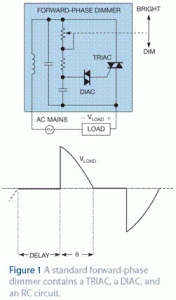Forward-phase Dimmers in LEDs
There are a large number of installed TRIAC dimmers in the worldwide, and they can prove a challenge to the control circuitry of an LED light. With such a large base, backward compatibility is a must.
The incandescent bulb occupied the leading position for more than one century in the the lighting industry, and, over the last 50 years, the phase dimmer has become the main dimming control. Standard forward-phase, or TRIAC (triode-alternating-current), dimmers are known to be difficult to interface with LED drivers. What make things worse is that the performance of each dimmer varies greatly. Although there are newer, better reverse-phase dimmers available, the standard forward-phase dimmer is so common in the world’s electrical infrastructure that LED-lighting manufacturers simply cannot ignore it. As usual, backward compatibility is paramount.
Forward-phase dimmers
A standard forward-phase dimmer contains a TRIAC, a DIAC (diode-alternating-current), and an RC (resistance/capacitance) circuit (Figure 1). A potentiometer controls the resistance, and the resulting RC time constant controls the amount of delay before the TRIAC turns on, or the firing angle. The portion of time when the TRIAC is on is the conduction angle, θ. The resulting voltage waveform is a phase-cut sinusoid.

This type of dimming works well in incandescent bulbs, which are simple resistive loads. The time-averaged voltage across the filament’s resistance decreases when the conduction angle decreases, providing naturally smooth dimming.
The TRIAC also has a minimum holding-current requirement. The current flowing through the TRIAC must remain above this minimum level to ensure that it remains on throughout the entire conduction angle. The incandescent load easily satisfies this condition because of the load’s inherent power levels—40, 60, and 75W, for example.
